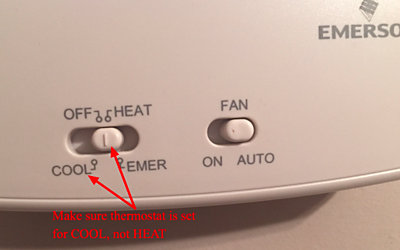Why Is My Home’s AC Blowing Warm Air?
Many problems can cause your AC to blow warm air. So, unless we inspect your unit, it’s nearly impossible for us to determine the exact problem you’re dealing with.
But you can take a stab at diagnosing your AC problem yourself if you look for the right signs.
If your AC is blowing warm air, you most likely have one of the following problems:
- Thermostat set to HEAT
- Refrigerant leak
- Outdoor unit won’t come on
We’ll explain each issue in detail and show you what you can do to fix the problem and what requires a professional.
Your thermostat is set to HEAT
We’re slowly coming out of the heating season and a lot of times; homeowners simply forget to move the thermostat tab from HEAT to COOL
So, to avoid an unnecessary service call, quickly check your settings and make sure you’ve set your thermostat to COOL.

You have a refrigerant leak
Your AC uses refrigerant to absorb the heat inside your home and release it outdoors. That refrigerant is housed in thin copper tubes that run throughout your HVAC system in a self-contained circuit.
But, if there’s a leak somewhere in the coil, refrigerant escapes and decreases your AC’s ability to cool the air in your home, which means you’ll feel warm air from the vents.
Other signs of a refrigerant leak include:
- A hissing or bubbling noise near refrigerant lines
- Ice on refrigerant lines (this will first happen at the evaporator coil then spread)
- Higher-than-normal energy bills

Ice on your AC's refrigerant lines or evaporator coil (seen here) could mean your system has a refrigerant leak.
Outdoor unit won’t come on
Your AC relies on the cooperation of two units:
- Your indoor unit, which absorbs heat from your home’s air
- The outdoor unit, which releases that heat into the outdoor air
So, if your outdoor unit won’t come on for whatever reason, your indoor unit will most likely continue to run but won’t be able to absorb the heat from the air. Meaning the air that is pushed out of the vents won’t be cooled.
Reasons your outdoor unit might not turn on include:
- A bad compressor
- A bad capacitor
- Your outdoor unit tripped its breaker
- The condenser coils are dirty or blocked
- Your outdoor unit’s emergency shutoff switch was flipped
How to fix it:
First, check that your outdoor unit is running. You can do this by going outside to your outdoor unit. You should see the fan spinning at the top of the condenser and hear the motor running. If you don’t, follow these steps to get your outdoor unit running again:
- Check that your emergency shutoff switch isn’t in the OFF position. This switch is usually inside a metal box near your outdoor unit.
- Check the condenser coils for dirt. If there’s a layer of dirt on the outdoor unit, it can cause the outdoor unit to overheat and shutoff. Use the hose on a gentle setting to remove dirt from the coils. Also make sure that any shrubbery, fences, or other barriers are at least 2 feet away from the outdoor unit to prevent it from overheating.
Need help from a Colorado Plumbing, Heating, Cooling, or Electrical Specialist?
For your convenience, you can request an appointment in one of two ways:
- Call us at (303) 436-2525 for immediate assistance.
- Click on the button below to schedule your appointment online.
Related Reading
Join Our Email Newsletter
Receive updates, current news, promotions, and industry tips.
